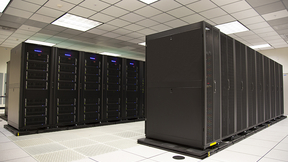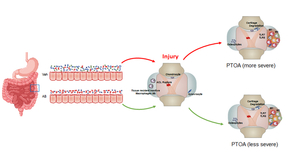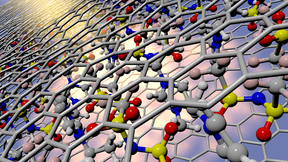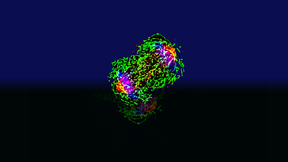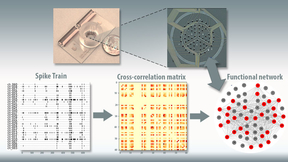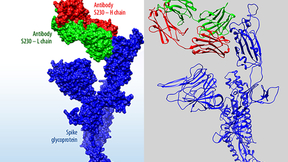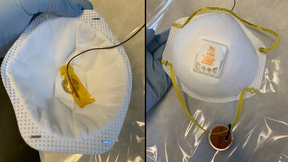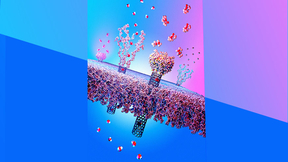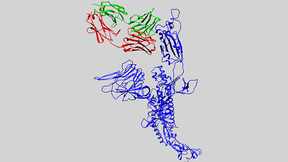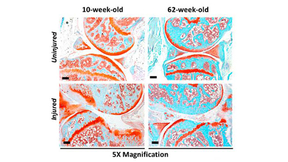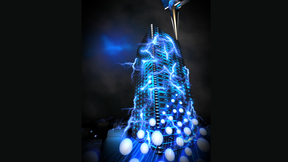Back
Bioscience and Bioengineering
Corona supercomputer gets funding for COVID-19 work
With funding from the Coronavirus Aid, Relief and Economic Security (CARES) Act, Lawrence Livermore National Laboratory (LLNL), chipmaker AMD and information technology company Supermicro have upgraded the supercomputing cluster Corona, providing additional resources to scientists for COVID-19 drug discovery and vaccine research. The recent addition of nearly 1,000 AMD…
Antibiotic pre-treatment reduces joint inflammation
Tearing an anterior cruciate ligament (ACL) can be an excruciatingly painful injury. Nearly 50 percent of these patients will develop a secondary form of osteoarthritis, deemed post-traumatic osteoarthritis (PTOA). Researchers from Lawrence Livermore National Laboratory (LLNL) and the UC Davis Medical Center have found that treatment with antibiotics prior to the injury…
Lab earns 'A' grade in OPCW test
In another month-and-a-half, a score of chemists from Lawrence Livermore National Laboratory's Forensic Science Center (FSC) will start two weeks of long days to undertake the Organization for the Prohibition of Chemical Weapons (OPCW) environmental proficiency test. Livermore chemists have been taking the proficiency tests each October since 2001, with LLNL serving as one…
LLNL an OPCW-designated lab for biomedical samples
In addition to maintaining its Organization for the Prohibition of Chemical Weapons (OPCW) laboratory designation for analyzing suspect environmental samples, LLNL also is an OPCW-designated laboratory for the analysis of biomedical samples. (See "Lab earns 'A' in OPCW test) In this instance, OPCW inspectors have the ability to collect biomedical samples for cases of…
Neuronal cultures advance ‘brain-on-a-chip’ technology
Lawrence Livermore National Laboratory (LLNL) researchers have increased the complexity of neuronal cultures grown on microelectrode arrays, a key step toward more accurately reproducing the cellular composition of the human brain outside the body. As described in a recently published paper in Scientific Reports, an LLNL team led by biomedical scientist Heather Enright…
Diving into the structure of molten salts in tight spaces
Room temperature ionic liquids (ILs), a special class of molten salts, promise far greater electrochemical performance compared to conventional aqueous solutions due to a suite of novel and tunable properties. Over the past two decades, ILs have been explored as a means of improving a range of different technologies, from energy storage and conversion to catalysis to…
E-waste-eating protein extracts rare earth elements
Lawrence Livermore National Laboratory (LLNL) researchers, in collaboration with Pennsylvania State University (PSU) and Idaho National Laboratory (INL), have designed a new process, based on a naturally occurring protein, that could extract and purify rare earth elements (REE) from low-grade sources. It could offer a new avenue toward a more diversified and sustainable…
Signaling breast cancer metastasis
Metastasis accounts for approximately 90 percent of mortality in breast cancer patients. During the last few decades, there has been significant progress in understanding genetic, molecular and signaling mechanisms underpinning cancer cell migration. Biologists from Lawrence Livermore National Laboratory (LLNL) found another mechanism that affects the maintenance and…
Modeling neuronal cultures on 'brain-on-a-chip' devices
For the past several years, Lawrence Livermore National Laboratory (LLNL) scientists and engineers have made significant progress in development of a three-dimensional “brain-on-a-chip” device capable of recording neural activity of human brain cell cultures grown outside the body. Now, LLNL researchers have a way to computationally model the activity and structures of…
COVID-19 research goes public through new portal
To help accelerate discovery of therapeutic antibodies or antiviral drugs for SARS-CoV-2, the virus that causes COVID-19, Lawrence Livermore National Laboratory (LLNL) has launched a searchable data portal to share its COVID-19 research with scientists worldwide and the general public. The portal houses a wealth of data LLNL scientists have gathered from their ongoing…
LLNL team helps develop tularemia vaccine
Two Lawrence Livermore National Laboratory (LLNL) researchers who have worked for more than eight years to develop a tularemia vaccine are part of a three-institution team that has been funded to bring their candidate to readiness for use. The two biomedical scientists, Nick Fischer and Amy Rasley, will collaborate with scientists from the University of New Mexico and the…
Deactivating coronavirus on N95 respirators for reuse
Lawrence Livermore National Laboratory (LLNL) researchers are studying ways to safely and rapidly remove viral threats from N95 respirators, without compromising the device’s fit and its ability to filter airborne particles, so they can be reused. As seen during the COVID-19 pandemic, a shortage of personal protective equipment, including surgical masks and respirators,…
Second skin protects against chem, bio agents
Recent events such as the COVID-19 pandemic and the use of chemical weapons in the Syria conflict have provided a stark reminder of the plethora of chemical and biological threats that soldiers, medical personnel and first responders face during routine and emergency operations. Personnel safety relies on protective equipment which, unfortunately, still leaves much to be…
New study aims to reduce osteoarthritis after injury
Gaby Loots and Aimy Sebastian (both BBTD) are embarking on a new five-year research project to identify ways to prevent post-traumatic osteoarthritis (OA) in knees and other joints as part of a $2.3 million grant awarded to UC Davis by the National Institutes of Health. Previous research shows that OA, or the breakdown of cartilage and other joint tissues, can be triggered…
LLNL’s new machine learning platform generates novel COVID-19 antibody sequences for experimental testing
Lawrence Livermore National Laboratory (LLNL) researchers have identified an initial set of therapeutic antibody sequences, designed in a few weeks using machine learning and supercomputing, aimed at binding and neutralizing SARS-CoV-2, the virus that causes COVID-19. The research team is performing experimental testing on the chosen antibody designs. Currently, treating…
LLNL researchers salvage broken arrow samples
It was a cool spring day in May 2019. LLNL researchers Mark Hart, Matt Lyman and Salustra Urbin were combing through rusted propellers and a split Mk4 bomb case in the foothills of Manzano Mountain, just a few miles east of Kirtland Air Force Base in New Mexico. The LLNL team was exploring three different plane crashes that had occurred on the mountain, but it was the…
Lab antibody, anti-viral research aids COVID-19 response
Lawrence Livermore National Laboratory (LLNL) scientists are contributing to the global fight against COVID-19 by combining artificial intelligence/machine learning, bioinformatics and supercomputing to help discover candidates for new antibodies and pharmaceutical drugs to combat the disease. See the visualization Backed by five high performance computing (HPC) clusters…
Injury-induced joint degeneration accelerated in older animals
Aging and injury are two major risk factors for osteoarthritis (OA), yet very little is known about how aging and injury interact and contribute to OA disease development. In a new study, researchers from LLNL, UC Merced, and UC Davis Medical Center examined age- and injury-related molecular changes in mouse knee joints that could contribute to OA. Using RNA sequencing,…
3D-printed aerogel electrodes boost energy storage
A team of Lawrence Livermore National Laboratory (LLNL) scientists and collaborators from the University of California, Santa Cruz (UCSC) and Sun Yat-Sen University have developed a new class of aerogel electrodes with a simultaneous boost in energy and power density. The research could be a boon for the energy storage industry. “This is the first example in which we were…
Lab teams recognized by Secretary of Energy awards
Former Secretary of Energy Rick Perry recognized Lawrence Livermore National Laboratory (LLNL) staff with six Secretary’s Honor Awards at a ceremony at Department of Energy (DOE) headquarters. The Secretary’s Honor Awards are bestowed on teams that have achieved a singular accomplishment that demonstrates a high level of performance and dedication to public service. As his…


